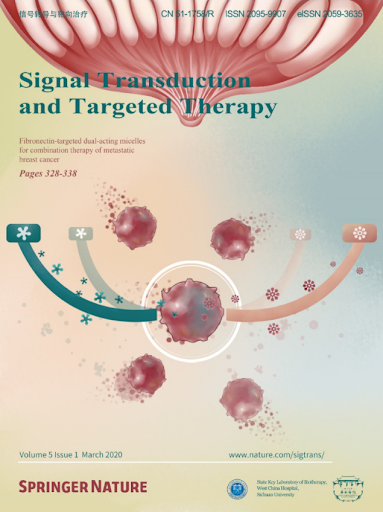In vivo self-assembled nano-PROTAC for the dual degradation of AR and HSP90 to overcome castration-resistant prostate cancer resistance.
IF 52.7
1区 医学
Q1 BIOCHEMISTRY & MOLECULAR BIOLOGY
引用次数: 0
Abstract
Castration-resistant prostate cancer demonstrates intrinsic or acquired resistance to second-generation androgen-targeted therapies, posing a challenge in clinical treatment. In this study, on the basis of in vivo self-assembly nanotechnology, we designed a PSMA-targeted nano-PROTAC with a proximity degradation effect. Nano-PROTAC not only precisely degrades the AR receptor but also cleverly degrades the HSP90 that is closely bound to the AR receptor, utilizing the spatial distance self-adaptive characteristics of its nanostructure. In the 22Rv1 cell model, Nano-PROTAC degraded 80% of the AR protein and 65% of the HSP90 protein. More importantly, nano-PROTAC could degrade 74% of the AR splice variant AR-V7 protein, showing the potential ability to overcome drug resistance. We further constructed an enzalutamide-resistant xenograft tumor mouse model to evaluate the therapeutic effect of the Nano-PROTAC. Compared with the combination treatment group of AR and HSP90 inhibitors (enzalutamide and pimitespib), the nano-PROTAC treatment group presented a high tumor growth inhibition value of up to 78% and a median survival extension of 15 days. Nano-PROTACs that simultaneously degrade AR and HSP90 can overcome the resistance of prostate cancer to PSMA- and AR-positive castration-resistant prostate cancer, except for neuroendocrine prostate cancer, which provides a new therapeutic strategy for the treatment of prostate cancer.体内自组装纳米protac用于AR和HSP90的双重降解,以克服去势抵抗性前列腺癌抗性。
去势抵抗性前列腺癌对第二代雄激素靶向治疗表现出内在或获得性耐药,给临床治疗带来挑战。在这项研究中,我们基于体内自组装纳米技术,设计了一种具有接近降解效果的psma靶向纳米protac。Nano-PROTAC不仅可以精确降解AR受体,还可以利用其纳米结构的空间距离自适应特性,巧妙地降解与AR受体紧密结合的HSP90。在22Rv1细胞模型中,Nano-PROTAC降解了80%的AR蛋白和65%的HSP90蛋白。更重要的是,纳米protac可以降解74%的AR剪接变体AR- v7蛋白,显示出克服耐药性的潜在能力。我们进一步构建了恩杂鲁胺耐药异种移植瘤小鼠模型,以评价纳米protac的治疗效果。与AR和HSP90抑制剂(enzalutamide和pimitespib)联合治疗组相比,纳米protac治疗组的肿瘤生长抑制值高达78%,中位生存期延长15天。同时降解AR和HSP90的纳米protacs可以克服前列腺癌对PSMA阳性和AR阳性去势抵抗性前列腺癌(除神经内分泌前列腺癌外)的耐药性,为前列腺癌的治疗提供了新的治疗策略。
本文章由计算机程序翻译,如有差异,请以英文原文为准。
求助全文
约1分钟内获得全文
求助全文
来源期刊

Signal Transduction and Targeted Therapy
Biochemistry, Genetics and Molecular Biology-Genetics
CiteScore
44.50
自引率
1.50%
发文量
384
审稿时长
5 weeks
期刊介绍:
Signal Transduction and Targeted Therapy is an open access journal that focuses on timely publication of cutting-edge discoveries and advancements in basic science and clinical research related to signal transduction and targeted therapy.
Scope: The journal covers research on major human diseases, including, but not limited to:
Cancer,Cardiovascular diseases,Autoimmune diseases,Nervous system diseases.
 求助内容:
求助内容: 应助结果提醒方式:
应助结果提醒方式:


